Strategies to Engage Primary Students in Science: A Sociology Report
VerifiedAdded on 2022/12/30
|15
|3891
|91
Report
AI Summary
This sociology report investigates the decline in primary school students' engagement with science and proposes methods to enhance their interest and participation. The report identifies the problem of a theoretical-heavy curriculum, emphasizing the need for practical application, diagrams, illustrations, and real-world observation. It suggests strategies like making students feel like real scientists through role-playing, experimental days, and the use of real data. The concept of 'science capital' is introduced, highlighting the importance of personalizing science and eliciting students' ideas. Research results from a study involving primary school students in Australia are presented, demonstrating positive outcomes when engagement strategies are implemented. The report concludes that intentional efforts to make students feel like scientists are effective in boosting their engagement and performance in science lessons, offering valuable insights for educators seeking to improve science education in primary schools.
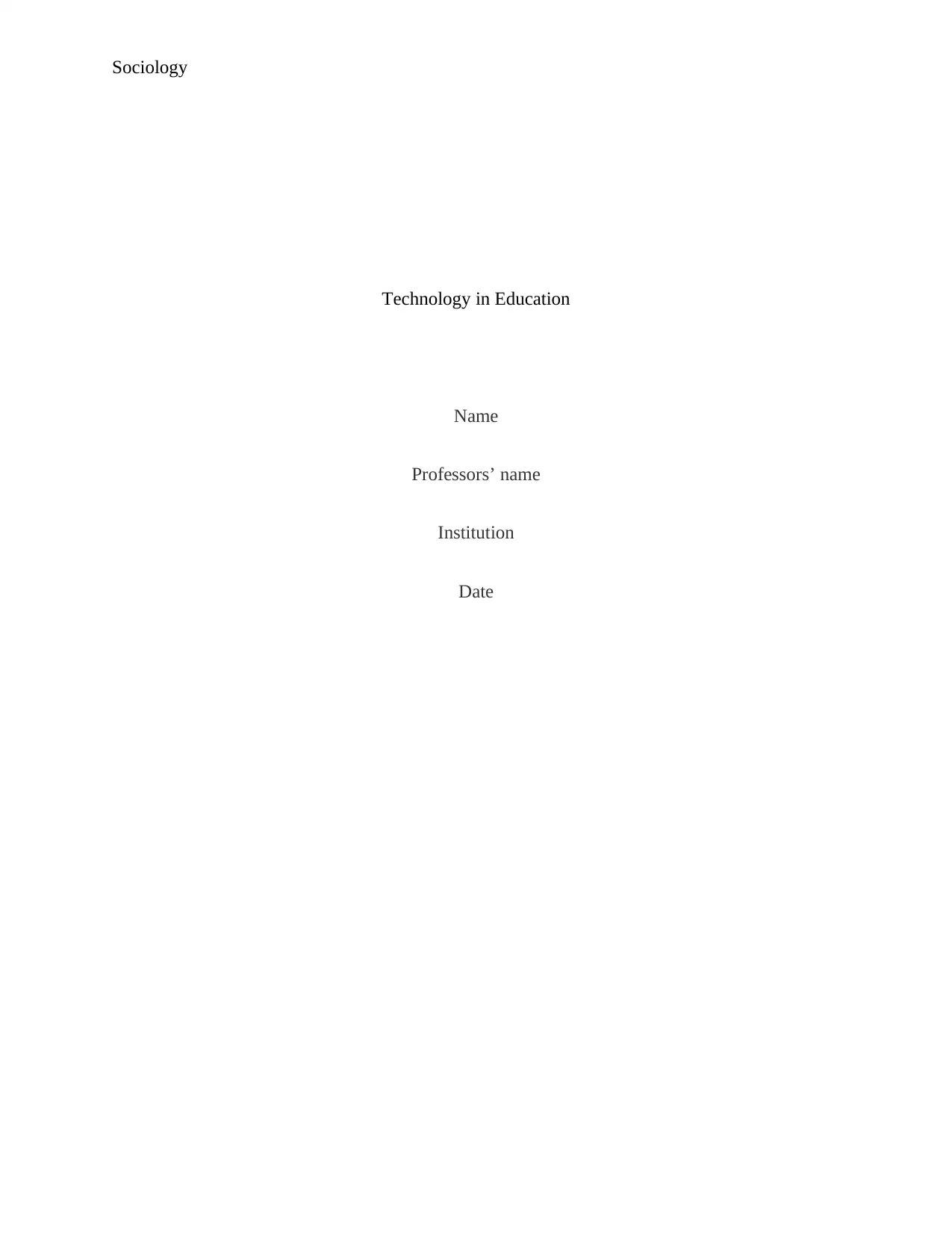
Sociology
Technology in Education
Name
Professors’ name
Institution
Date
Technology in Education
Name
Professors’ name
Institution
Date
Paraphrase This Document
Need a fresh take? Get an instant paraphrase of this document with our AI Paraphraser
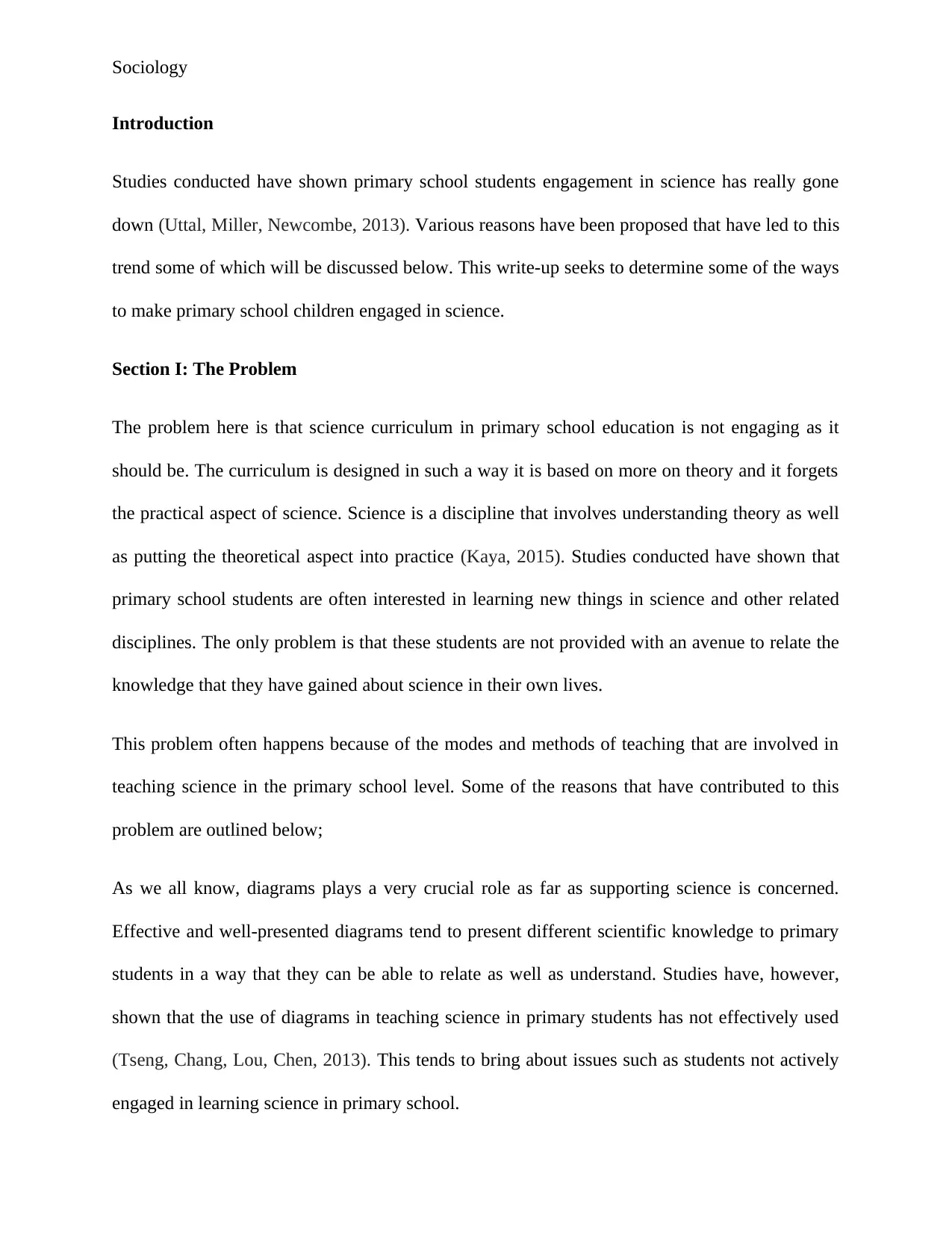
Sociology
Introduction
Studies conducted have shown primary school students engagement in science has really gone
down (Uttal, Miller, Newcombe, 2013). Various reasons have been proposed that have led to this
trend some of which will be discussed below. This write-up seeks to determine some of the ways
to make primary school children engaged in science.
Section I: The Problem
The problem here is that science curriculum in primary school education is not engaging as it
should be. The curriculum is designed in such a way it is based on more on theory and it forgets
the practical aspect of science. Science is a discipline that involves understanding theory as well
as putting the theoretical aspect into practice (Kaya, 2015). Studies conducted have shown that
primary school students are often interested in learning new things in science and other related
disciplines. The only problem is that these students are not provided with an avenue to relate the
knowledge that they have gained about science in their own lives.
This problem often happens because of the modes and methods of teaching that are involved in
teaching science in the primary school level. Some of the reasons that have contributed to this
problem are outlined below;
As we all know, diagrams plays a very crucial role as far as supporting science is concerned.
Effective and well-presented diagrams tend to present different scientific knowledge to primary
students in a way that they can be able to relate as well as understand. Studies have, however,
shown that the use of diagrams in teaching science in primary students has not effectively used
(Tseng, Chang, Lou, Chen, 2013). This tends to bring about issues such as students not actively
engaged in learning science in primary school.
Introduction
Studies conducted have shown primary school students engagement in science has really gone
down (Uttal, Miller, Newcombe, 2013). Various reasons have been proposed that have led to this
trend some of which will be discussed below. This write-up seeks to determine some of the ways
to make primary school children engaged in science.
Section I: The Problem
The problem here is that science curriculum in primary school education is not engaging as it
should be. The curriculum is designed in such a way it is based on more on theory and it forgets
the practical aspect of science. Science is a discipline that involves understanding theory as well
as putting the theoretical aspect into practice (Kaya, 2015). Studies conducted have shown that
primary school students are often interested in learning new things in science and other related
disciplines. The only problem is that these students are not provided with an avenue to relate the
knowledge that they have gained about science in their own lives.
This problem often happens because of the modes and methods of teaching that are involved in
teaching science in the primary school level. Some of the reasons that have contributed to this
problem are outlined below;
As we all know, diagrams plays a very crucial role as far as supporting science is concerned.
Effective and well-presented diagrams tend to present different scientific knowledge to primary
students in a way that they can be able to relate as well as understand. Studies have, however,
shown that the use of diagrams in teaching science in primary students has not effectively used
(Tseng, Chang, Lou, Chen, 2013). This tends to bring about issues such as students not actively
engaged in learning science in primary school.
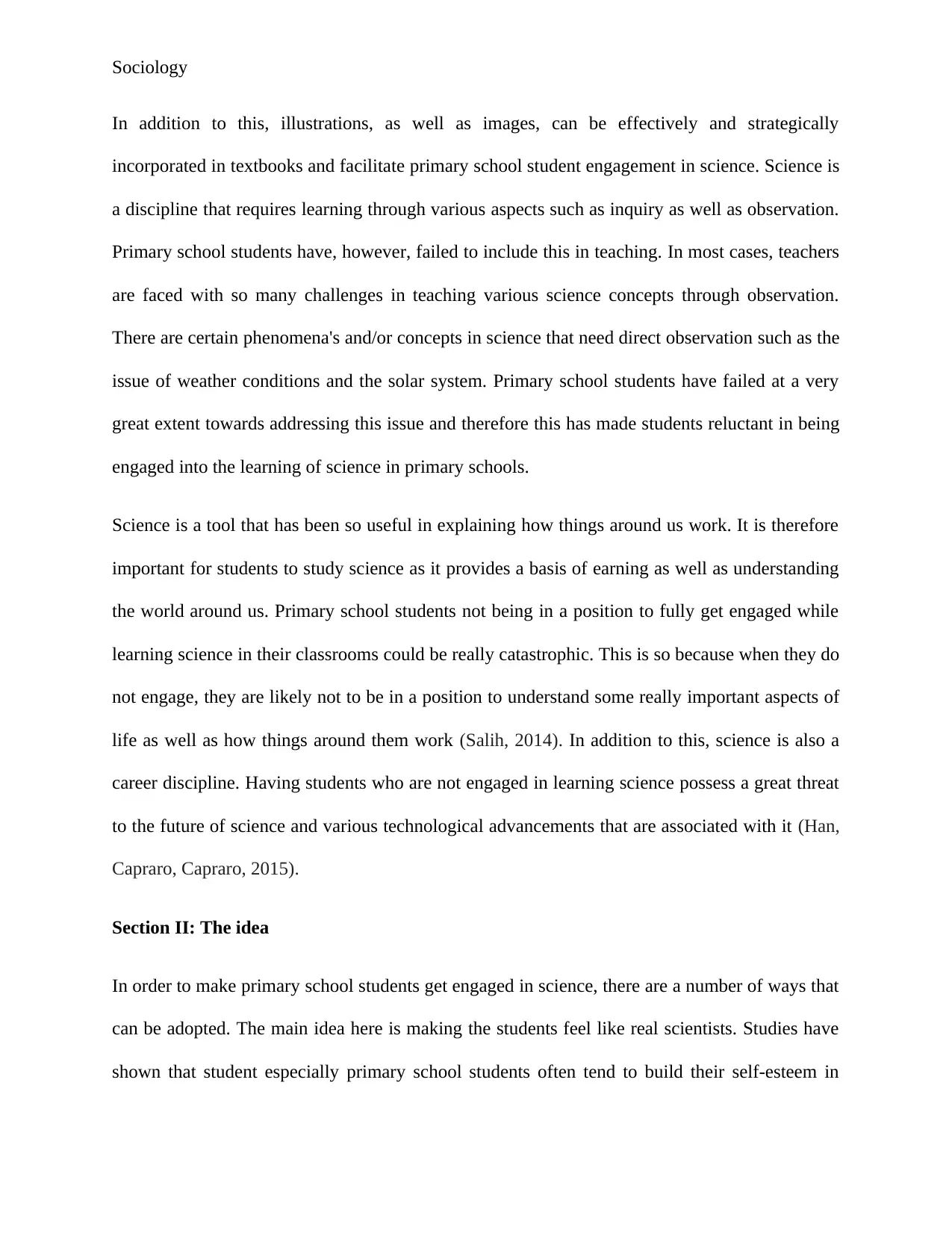
Sociology
In addition to this, illustrations, as well as images, can be effectively and strategically
incorporated in textbooks and facilitate primary school student engagement in science. Science is
a discipline that requires learning through various aspects such as inquiry as well as observation.
Primary school students have, however, failed to include this in teaching. In most cases, teachers
are faced with so many challenges in teaching various science concepts through observation.
There are certain phenomena's and/or concepts in science that need direct observation such as the
issue of weather conditions and the solar system. Primary school students have failed at a very
great extent towards addressing this issue and therefore this has made students reluctant in being
engaged into the learning of science in primary schools.
Science is a tool that has been so useful in explaining how things around us work. It is therefore
important for students to study science as it provides a basis of earning as well as understanding
the world around us. Primary school students not being in a position to fully get engaged while
learning science in their classrooms could be really catastrophic. This is so because when they do
not engage, they are likely not to be in a position to understand some really important aspects of
life as well as how things around them work (Salih, 2014). In addition to this, science is also a
career discipline. Having students who are not engaged in learning science possess a great threat
to the future of science and various technological advancements that are associated with it (Han,
Capraro, Capraro, 2015).
Section II: The idea
In order to make primary school students get engaged in science, there are a number of ways that
can be adopted. The main idea here is making the students feel like real scientists. Studies have
shown that student especially primary school students often tend to build their self-esteem in
In addition to this, illustrations, as well as images, can be effectively and strategically
incorporated in textbooks and facilitate primary school student engagement in science. Science is
a discipline that requires learning through various aspects such as inquiry as well as observation.
Primary school students have, however, failed to include this in teaching. In most cases, teachers
are faced with so many challenges in teaching various science concepts through observation.
There are certain phenomena's and/or concepts in science that need direct observation such as the
issue of weather conditions and the solar system. Primary school students have failed at a very
great extent towards addressing this issue and therefore this has made students reluctant in being
engaged into the learning of science in primary schools.
Science is a tool that has been so useful in explaining how things around us work. It is therefore
important for students to study science as it provides a basis of earning as well as understanding
the world around us. Primary school students not being in a position to fully get engaged while
learning science in their classrooms could be really catastrophic. This is so because when they do
not engage, they are likely not to be in a position to understand some really important aspects of
life as well as how things around them work (Salih, 2014). In addition to this, science is also a
career discipline. Having students who are not engaged in learning science possess a great threat
to the future of science and various technological advancements that are associated with it (Han,
Capraro, Capraro, 2015).
Section II: The idea
In order to make primary school students get engaged in science, there are a number of ways that
can be adopted. The main idea here is making the students feel like real scientists. Studies have
shown that student especially primary school students often tend to build their self-esteem in
⊘ This is a preview!⊘
Do you want full access?
Subscribe today to unlock all pages.

Trusted by 1+ million students worldwide
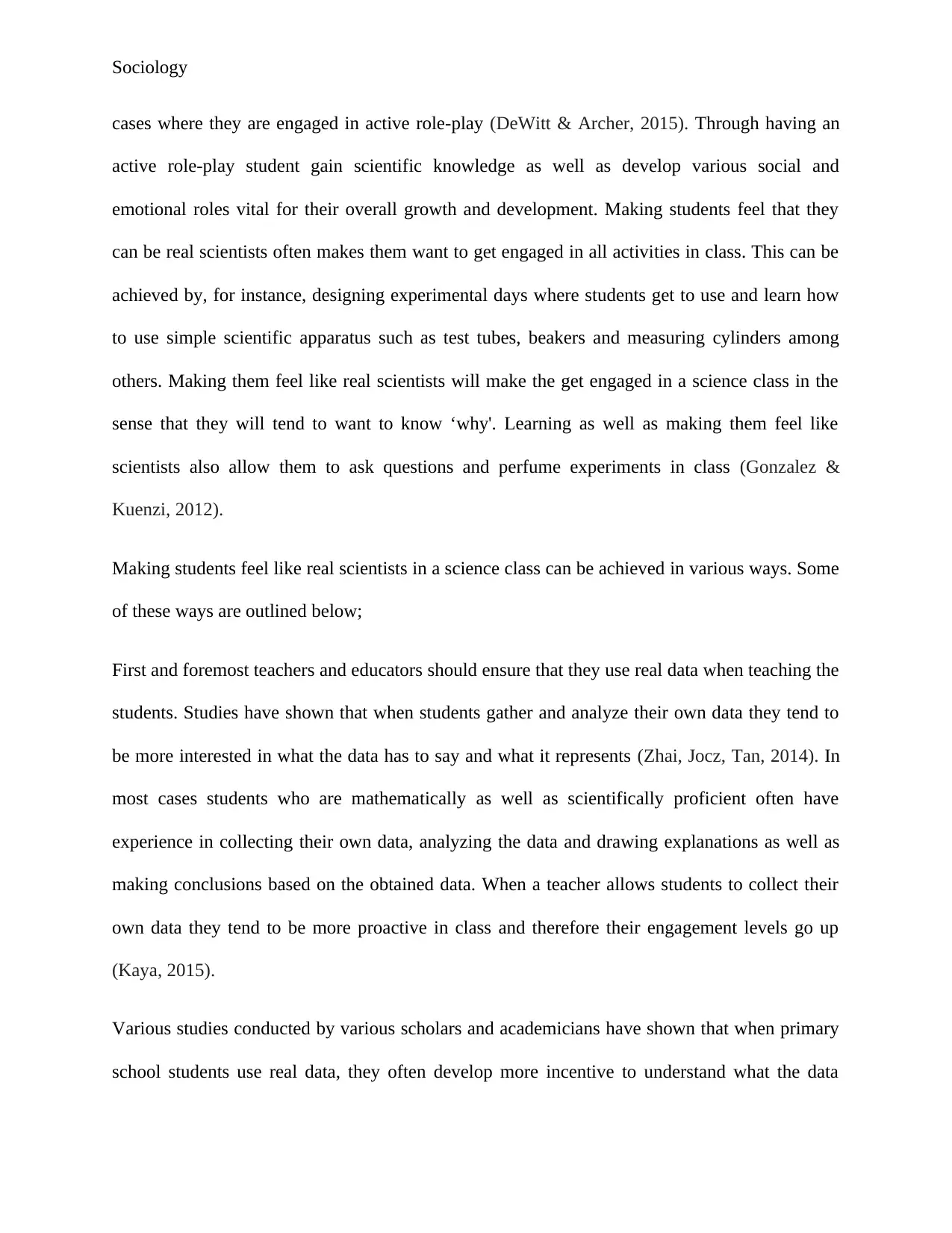
Sociology
cases where they are engaged in active role-play (DeWitt & Archer, 2015). Through having an
active role-play student gain scientific knowledge as well as develop various social and
emotional roles vital for their overall growth and development. Making students feel that they
can be real scientists often makes them want to get engaged in all activities in class. This can be
achieved by, for instance, designing experimental days where students get to use and learn how
to use simple scientific apparatus such as test tubes, beakers and measuring cylinders among
others. Making them feel like real scientists will make the get engaged in a science class in the
sense that they will tend to want to know ‘why'. Learning as well as making them feel like
scientists also allow them to ask questions and perfume experiments in class (Gonzalez &
Kuenzi, 2012).
Making students feel like real scientists in a science class can be achieved in various ways. Some
of these ways are outlined below;
First and foremost teachers and educators should ensure that they use real data when teaching the
students. Studies have shown that when students gather and analyze their own data they tend to
be more interested in what the data has to say and what it represents (Zhai, Jocz, Tan, 2014). In
most cases students who are mathematically as well as scientifically proficient often have
experience in collecting their own data, analyzing the data and drawing explanations as well as
making conclusions based on the obtained data. When a teacher allows students to collect their
own data they tend to be more proactive in class and therefore their engagement levels go up
(Kaya, 2015).
Various studies conducted by various scholars and academicians have shown that when primary
school students use real data, they often develop more incentive to understand what the data
cases where they are engaged in active role-play (DeWitt & Archer, 2015). Through having an
active role-play student gain scientific knowledge as well as develop various social and
emotional roles vital for their overall growth and development. Making students feel that they
can be real scientists often makes them want to get engaged in all activities in class. This can be
achieved by, for instance, designing experimental days where students get to use and learn how
to use simple scientific apparatus such as test tubes, beakers and measuring cylinders among
others. Making them feel like real scientists will make the get engaged in a science class in the
sense that they will tend to want to know ‘why'. Learning as well as making them feel like
scientists also allow them to ask questions and perfume experiments in class (Gonzalez &
Kuenzi, 2012).
Making students feel like real scientists in a science class can be achieved in various ways. Some
of these ways are outlined below;
First and foremost teachers and educators should ensure that they use real data when teaching the
students. Studies have shown that when students gather and analyze their own data they tend to
be more interested in what the data has to say and what it represents (Zhai, Jocz, Tan, 2014). In
most cases students who are mathematically as well as scientifically proficient often have
experience in collecting their own data, analyzing the data and drawing explanations as well as
making conclusions based on the obtained data. When a teacher allows students to collect their
own data they tend to be more proactive in class and therefore their engagement levels go up
(Kaya, 2015).
Various studies conducted by various scholars and academicians have shown that when primary
school students use real data, they often develop more incentive to understand what the data
Paraphrase This Document
Need a fresh take? Get an instant paraphrase of this document with our AI Paraphraser
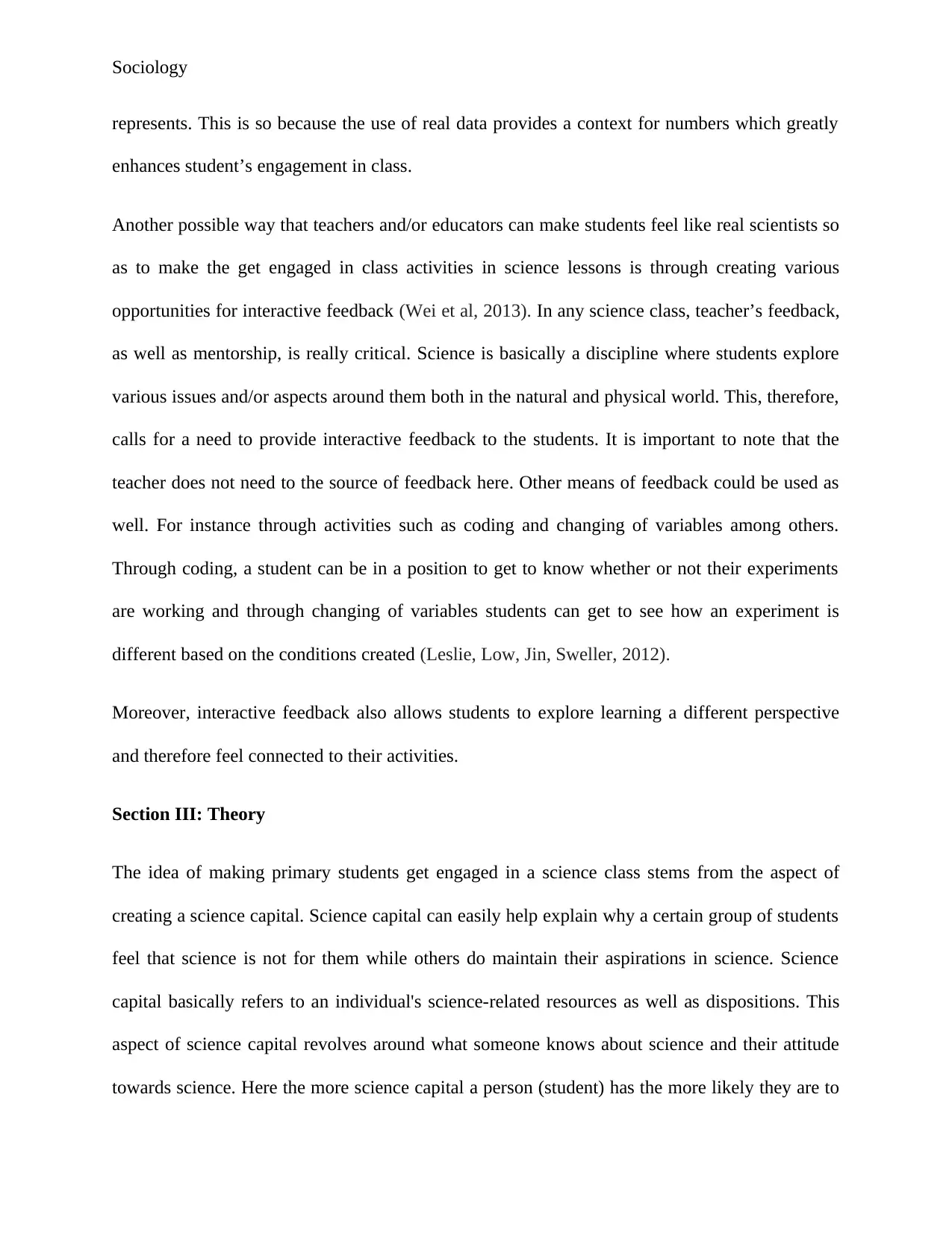
Sociology
represents. This is so because the use of real data provides a context for numbers which greatly
enhances student’s engagement in class.
Another possible way that teachers and/or educators can make students feel like real scientists so
as to make the get engaged in class activities in science lessons is through creating various
opportunities for interactive feedback (Wei et al, 2013). In any science class, teacher’s feedback,
as well as mentorship, is really critical. Science is basically a discipline where students explore
various issues and/or aspects around them both in the natural and physical world. This, therefore,
calls for a need to provide interactive feedback to the students. It is important to note that the
teacher does not need to the source of feedback here. Other means of feedback could be used as
well. For instance through activities such as coding and changing of variables among others.
Through coding, a student can be in a position to get to know whether or not their experiments
are working and through changing of variables students can get to see how an experiment is
different based on the conditions created (Leslie, Low, Jin, Sweller, 2012).
Moreover, interactive feedback also allows students to explore learning a different perspective
and therefore feel connected to their activities.
Section III: Theory
The idea of making primary students get engaged in a science class stems from the aspect of
creating a science capital. Science capital can easily help explain why a certain group of students
feel that science is not for them while others do maintain their aspirations in science. Science
capital basically refers to an individual's science-related resources as well as dispositions. This
aspect of science capital revolves around what someone knows about science and their attitude
towards science. Here the more science capital a person (student) has the more likely they are to
represents. This is so because the use of real data provides a context for numbers which greatly
enhances student’s engagement in class.
Another possible way that teachers and/or educators can make students feel like real scientists so
as to make the get engaged in class activities in science lessons is through creating various
opportunities for interactive feedback (Wei et al, 2013). In any science class, teacher’s feedback,
as well as mentorship, is really critical. Science is basically a discipline where students explore
various issues and/or aspects around them both in the natural and physical world. This, therefore,
calls for a need to provide interactive feedback to the students. It is important to note that the
teacher does not need to the source of feedback here. Other means of feedback could be used as
well. For instance through activities such as coding and changing of variables among others.
Through coding, a student can be in a position to get to know whether or not their experiments
are working and through changing of variables students can get to see how an experiment is
different based on the conditions created (Leslie, Low, Jin, Sweller, 2012).
Moreover, interactive feedback also allows students to explore learning a different perspective
and therefore feel connected to their activities.
Section III: Theory
The idea of making primary students get engaged in a science class stems from the aspect of
creating a science capital. Science capital can easily help explain why a certain group of students
feel that science is not for them while others do maintain their aspirations in science. Science
capital basically refers to an individual's science-related resources as well as dispositions. This
aspect of science capital revolves around what someone knows about science and their attitude
towards science. Here the more science capital a person (student) has the more likely they are to
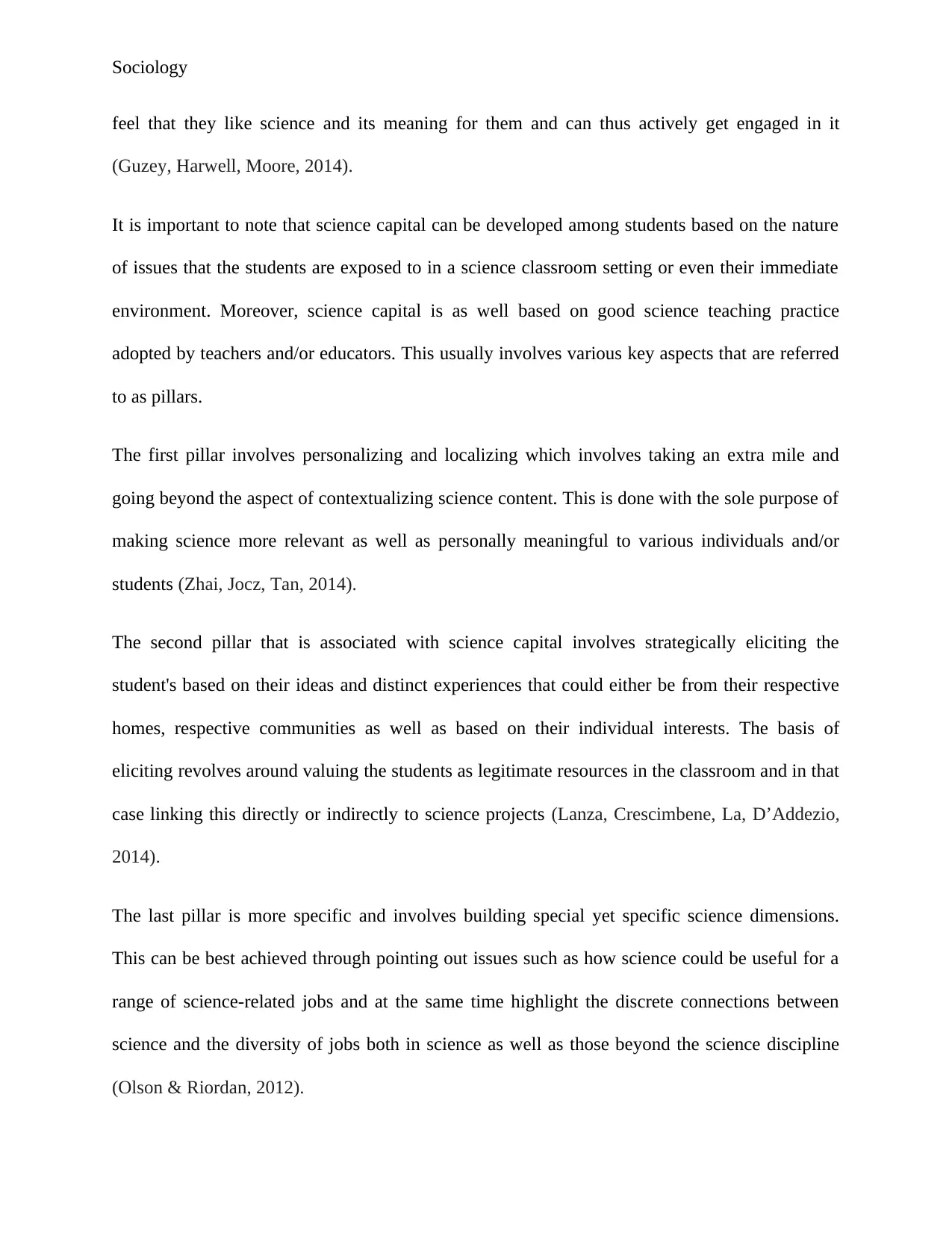
Sociology
feel that they like science and its meaning for them and can thus actively get engaged in it
(Guzey, Harwell, Moore, 2014).
It is important to note that science capital can be developed among students based on the nature
of issues that the students are exposed to in a science classroom setting or even their immediate
environment. Moreover, science capital is as well based on good science teaching practice
adopted by teachers and/or educators. This usually involves various key aspects that are referred
to as pillars.
The first pillar involves personalizing and localizing which involves taking an extra mile and
going beyond the aspect of contextualizing science content. This is done with the sole purpose of
making science more relevant as well as personally meaningful to various individuals and/or
students (Zhai, Jocz, Tan, 2014).
The second pillar that is associated with science capital involves strategically eliciting the
student's based on their ideas and distinct experiences that could either be from their respective
homes, respective communities as well as based on their individual interests. The basis of
eliciting revolves around valuing the students as legitimate resources in the classroom and in that
case linking this directly or indirectly to science projects (Lanza, Crescimbene, La, D’Addezio,
2014).
The last pillar is more specific and involves building special yet specific science dimensions.
This can be best achieved through pointing out issues such as how science could be useful for a
range of science-related jobs and at the same time highlight the discrete connections between
science and the diversity of jobs both in science as well as those beyond the science discipline
(Olson & Riordan, 2012).
feel that they like science and its meaning for them and can thus actively get engaged in it
(Guzey, Harwell, Moore, 2014).
It is important to note that science capital can be developed among students based on the nature
of issues that the students are exposed to in a science classroom setting or even their immediate
environment. Moreover, science capital is as well based on good science teaching practice
adopted by teachers and/or educators. This usually involves various key aspects that are referred
to as pillars.
The first pillar involves personalizing and localizing which involves taking an extra mile and
going beyond the aspect of contextualizing science content. This is done with the sole purpose of
making science more relevant as well as personally meaningful to various individuals and/or
students (Zhai, Jocz, Tan, 2014).
The second pillar that is associated with science capital involves strategically eliciting the
student's based on their ideas and distinct experiences that could either be from their respective
homes, respective communities as well as based on their individual interests. The basis of
eliciting revolves around valuing the students as legitimate resources in the classroom and in that
case linking this directly or indirectly to science projects (Lanza, Crescimbene, La, D’Addezio,
2014).
The last pillar is more specific and involves building special yet specific science dimensions.
This can be best achieved through pointing out issues such as how science could be useful for a
range of science-related jobs and at the same time highlight the discrete connections between
science and the diversity of jobs both in science as well as those beyond the science discipline
(Olson & Riordan, 2012).
⊘ This is a preview!⊘
Do you want full access?
Subscribe today to unlock all pages.

Trusted by 1+ million students worldwide
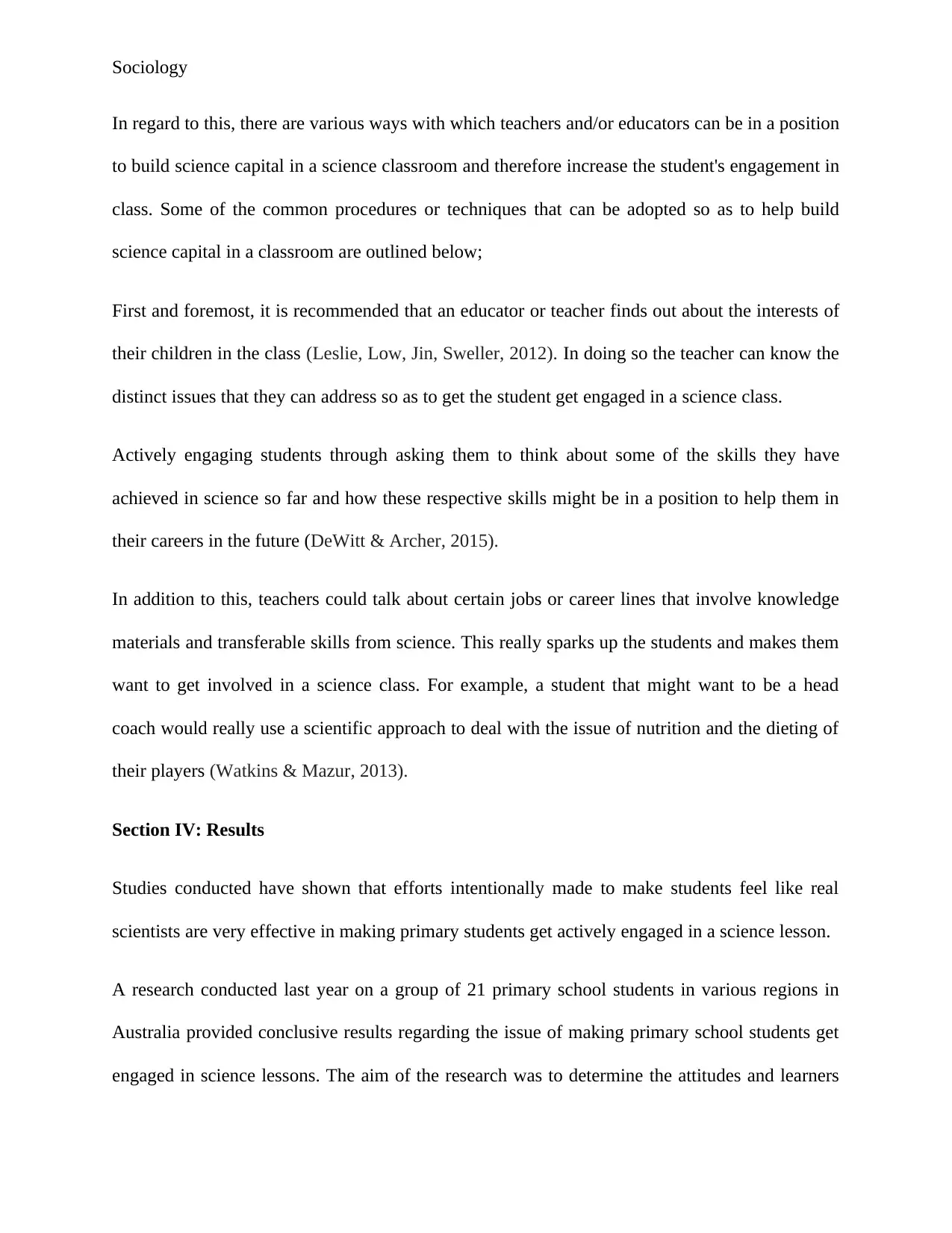
Sociology
In regard to this, there are various ways with which teachers and/or educators can be in a position
to build science capital in a science classroom and therefore increase the student's engagement in
class. Some of the common procedures or techniques that can be adopted so as to help build
science capital in a classroom are outlined below;
First and foremost, it is recommended that an educator or teacher finds out about the interests of
their children in the class (Leslie, Low, Jin, Sweller, 2012). In doing so the teacher can know the
distinct issues that they can address so as to get the student get engaged in a science class.
Actively engaging students through asking them to think about some of the skills they have
achieved in science so far and how these respective skills might be in a position to help them in
their careers in the future (DeWitt & Archer, 2015).
In addition to this, teachers could talk about certain jobs or career lines that involve knowledge
materials and transferable skills from science. This really sparks up the students and makes them
want to get involved in a science class. For example, a student that might want to be a head
coach would really use a scientific approach to deal with the issue of nutrition and the dieting of
their players (Watkins & Mazur, 2013).
Section IV: Results
Studies conducted have shown that efforts intentionally made to make students feel like real
scientists are very effective in making primary students get actively engaged in a science lesson.
A research conducted last year on a group of 21 primary school students in various regions in
Australia provided conclusive results regarding the issue of making primary school students get
engaged in science lessons. The aim of the research was to determine the attitudes and learners
In regard to this, there are various ways with which teachers and/or educators can be in a position
to build science capital in a science classroom and therefore increase the student's engagement in
class. Some of the common procedures or techniques that can be adopted so as to help build
science capital in a classroom are outlined below;
First and foremost, it is recommended that an educator or teacher finds out about the interests of
their children in the class (Leslie, Low, Jin, Sweller, 2012). In doing so the teacher can know the
distinct issues that they can address so as to get the student get engaged in a science class.
Actively engaging students through asking them to think about some of the skills they have
achieved in science so far and how these respective skills might be in a position to help them in
their careers in the future (DeWitt & Archer, 2015).
In addition to this, teachers could talk about certain jobs or career lines that involve knowledge
materials and transferable skills from science. This really sparks up the students and makes them
want to get involved in a science class. For example, a student that might want to be a head
coach would really use a scientific approach to deal with the issue of nutrition and the dieting of
their players (Watkins & Mazur, 2013).
Section IV: Results
Studies conducted have shown that efforts intentionally made to make students feel like real
scientists are very effective in making primary students get actively engaged in a science lesson.
A research conducted last year on a group of 21 primary school students in various regions in
Australia provided conclusive results regarding the issue of making primary school students get
engaged in science lessons. The aim of the research was to determine the attitudes and learners
Paraphrase This Document
Need a fresh take? Get an instant paraphrase of this document with our AI Paraphraser
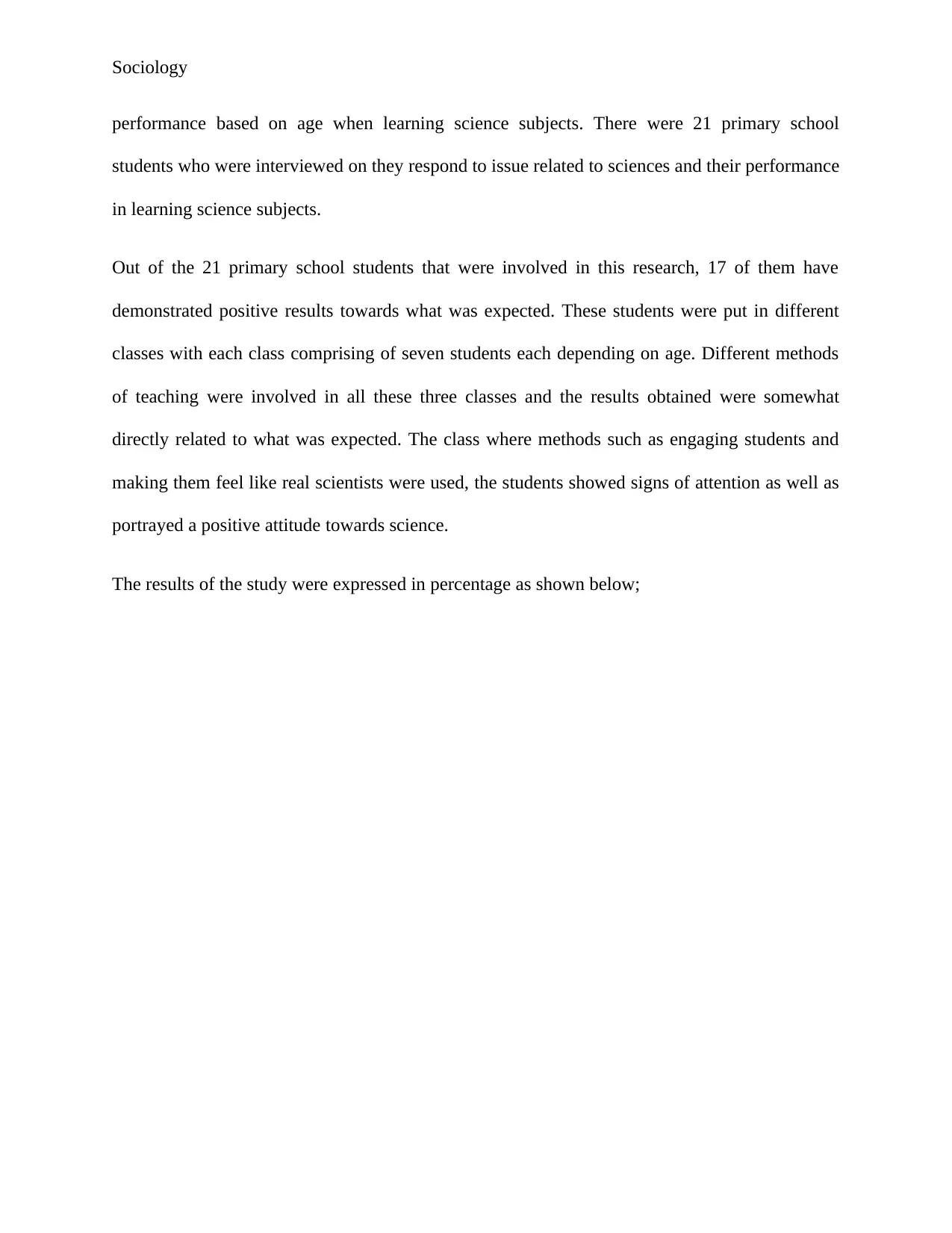
Sociology
performance based on age when learning science subjects. There were 21 primary school
students who were interviewed on they respond to issue related to sciences and their performance
in learning science subjects.
Out of the 21 primary school students that were involved in this research, 17 of them have
demonstrated positive results towards what was expected. These students were put in different
classes with each class comprising of seven students each depending on age. Different methods
of teaching were involved in all these three classes and the results obtained were somewhat
directly related to what was expected. The class where methods such as engaging students and
making them feel like real scientists were used, the students showed signs of attention as well as
portrayed a positive attitude towards science.
The results of the study were expressed in percentage as shown below;
performance based on age when learning science subjects. There were 21 primary school
students who were interviewed on they respond to issue related to sciences and their performance
in learning science subjects.
Out of the 21 primary school students that were involved in this research, 17 of them have
demonstrated positive results towards what was expected. These students were put in different
classes with each class comprising of seven students each depending on age. Different methods
of teaching were involved in all these three classes and the results obtained were somewhat
directly related to what was expected. The class where methods such as engaging students and
making them feel like real scientists were used, the students showed signs of attention as well as
portrayed a positive attitude towards science.
The results of the study were expressed in percentage as shown below;
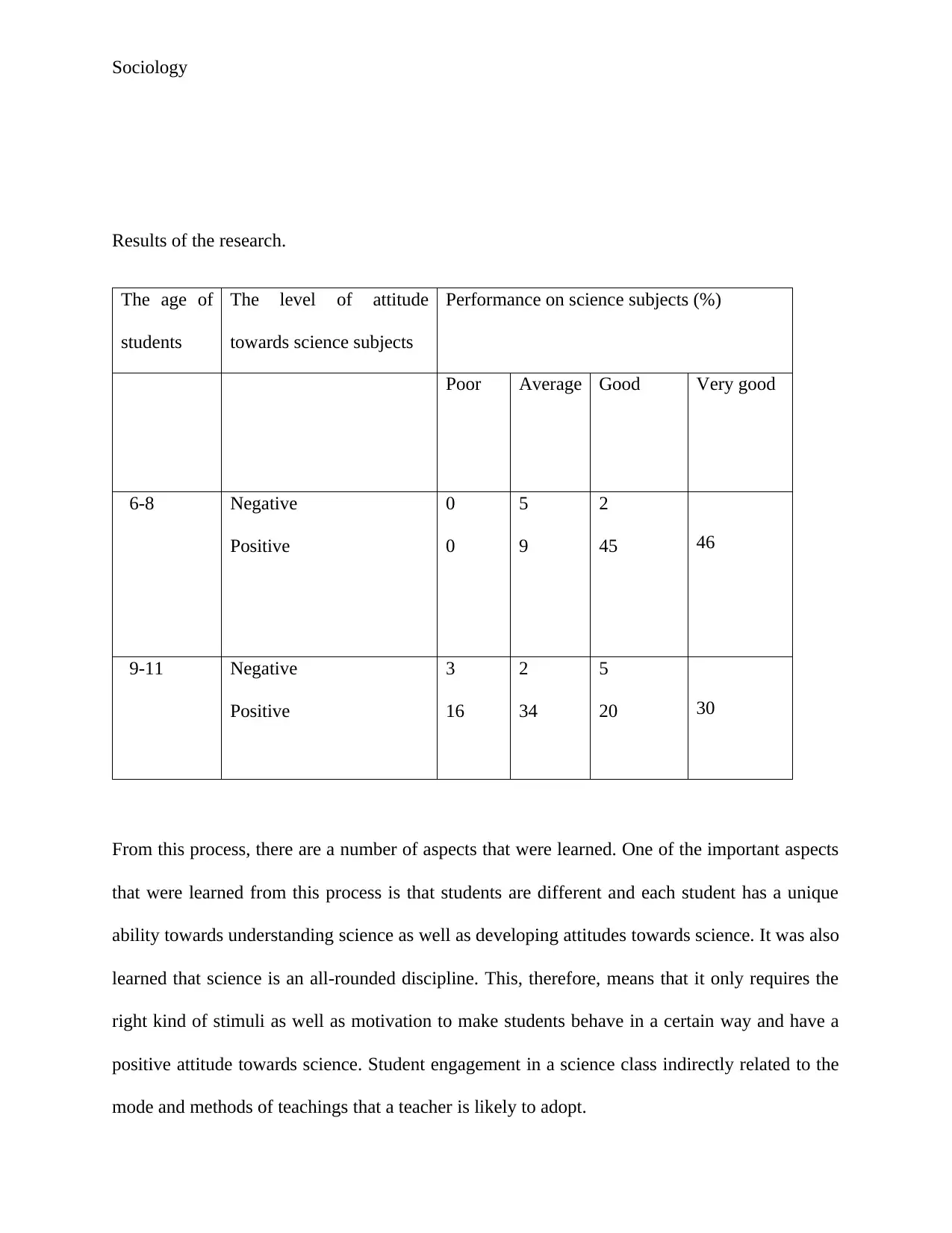
Sociology
Results of the research.
The age of
students
The level of attitude
towards science subjects
Performance on science subjects (%)
Poor Average Good Very good
6-8 Negative
Positive
0
0
5
9
2
45 46
9-11 Negative
Positive
3
16
2
34
5
20 30
From this process, there are a number of aspects that were learned. One of the important aspects
that were learned from this process is that students are different and each student has a unique
ability towards understanding science as well as developing attitudes towards science. It was also
learned that science is an all-rounded discipline. This, therefore, means that it only requires the
right kind of stimuli as well as motivation to make students behave in a certain way and have a
positive attitude towards science. Student engagement in a science class indirectly related to the
mode and methods of teachings that a teacher is likely to adopt.
Results of the research.
The age of
students
The level of attitude
towards science subjects
Performance on science subjects (%)
Poor Average Good Very good
6-8 Negative
Positive
0
0
5
9
2
45 46
9-11 Negative
Positive
3
16
2
34
5
20 30
From this process, there are a number of aspects that were learned. One of the important aspects
that were learned from this process is that students are different and each student has a unique
ability towards understanding science as well as developing attitudes towards science. It was also
learned that science is an all-rounded discipline. This, therefore, means that it only requires the
right kind of stimuli as well as motivation to make students behave in a certain way and have a
positive attitude towards science. Student engagement in a science class indirectly related to the
mode and methods of teachings that a teacher is likely to adopt.
⊘ This is a preview!⊘
Do you want full access?
Subscribe today to unlock all pages.

Trusted by 1+ million students worldwide
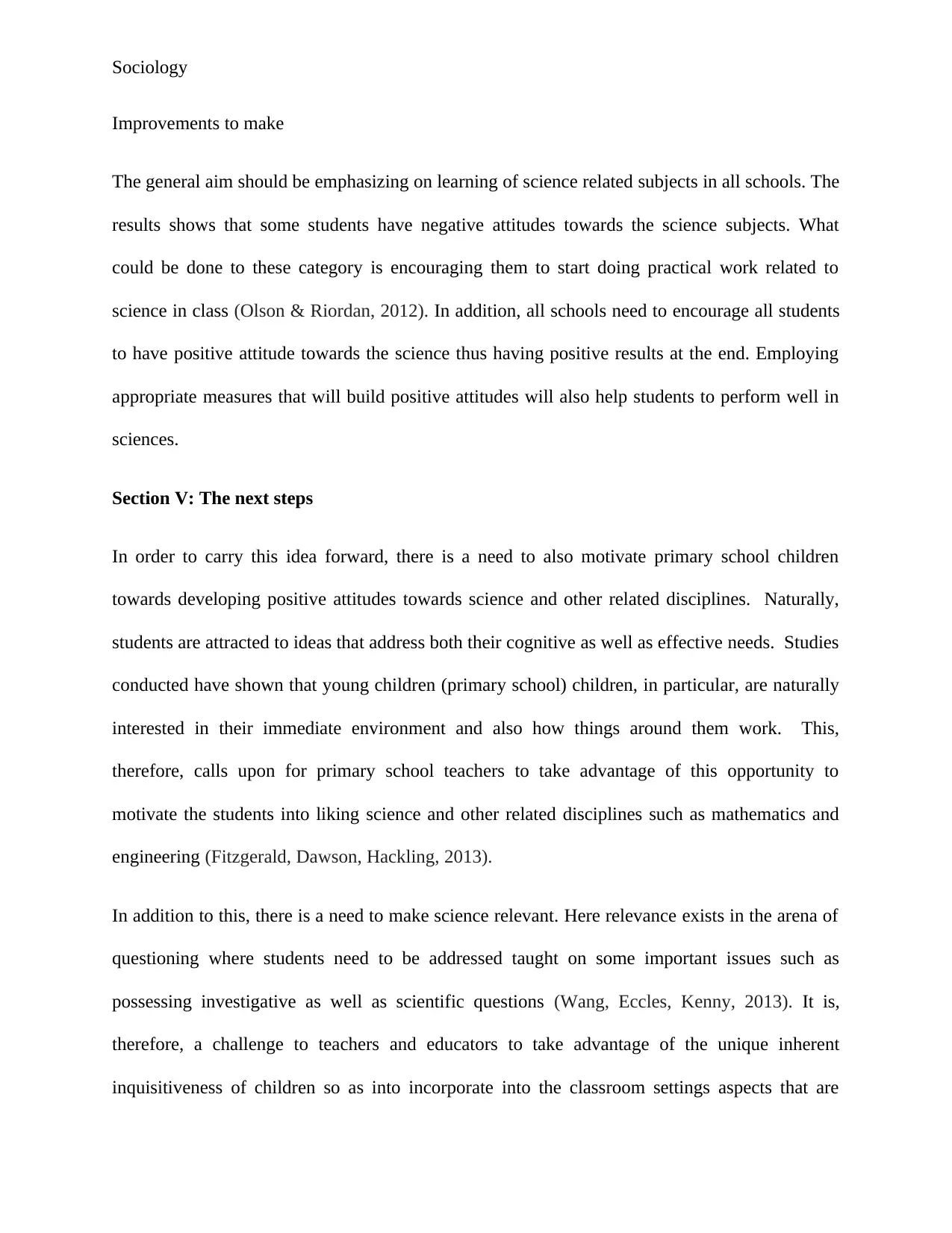
Sociology
Improvements to make
The general aim should be emphasizing on learning of science related subjects in all schools. The
results shows that some students have negative attitudes towards the science subjects. What
could be done to these category is encouraging them to start doing practical work related to
science in class (Olson & Riordan, 2012). In addition, all schools need to encourage all students
to have positive attitude towards the science thus having positive results at the end. Employing
appropriate measures that will build positive attitudes will also help students to perform well in
sciences.
Section V: The next steps
In order to carry this idea forward, there is a need to also motivate primary school children
towards developing positive attitudes towards science and other related disciplines. Naturally,
students are attracted to ideas that address both their cognitive as well as effective needs. Studies
conducted have shown that young children (primary school) children, in particular, are naturally
interested in their immediate environment and also how things around them work. This,
therefore, calls upon for primary school teachers to take advantage of this opportunity to
motivate the students into liking science and other related disciplines such as mathematics and
engineering (Fitzgerald, Dawson, Hackling, 2013).
In addition to this, there is a need to make science relevant. Here relevance exists in the arena of
questioning where students need to be addressed taught on some important issues such as
possessing investigative as well as scientific questions (Wang, Eccles, Kenny, 2013). It is,
therefore, a challenge to teachers and educators to take advantage of the unique inherent
inquisitiveness of children so as into incorporate into the classroom settings aspects that are
Improvements to make
The general aim should be emphasizing on learning of science related subjects in all schools. The
results shows that some students have negative attitudes towards the science subjects. What
could be done to these category is encouraging them to start doing practical work related to
science in class (Olson & Riordan, 2012). In addition, all schools need to encourage all students
to have positive attitude towards the science thus having positive results at the end. Employing
appropriate measures that will build positive attitudes will also help students to perform well in
sciences.
Section V: The next steps
In order to carry this idea forward, there is a need to also motivate primary school children
towards developing positive attitudes towards science and other related disciplines. Naturally,
students are attracted to ideas that address both their cognitive as well as effective needs. Studies
conducted have shown that young children (primary school) children, in particular, are naturally
interested in their immediate environment and also how things around them work. This,
therefore, calls upon for primary school teachers to take advantage of this opportunity to
motivate the students into liking science and other related disciplines such as mathematics and
engineering (Fitzgerald, Dawson, Hackling, 2013).
In addition to this, there is a need to make science relevant. Here relevance exists in the arena of
questioning where students need to be addressed taught on some important issues such as
possessing investigative as well as scientific questions (Wang, Eccles, Kenny, 2013). It is,
therefore, a challenge to teachers and educators to take advantage of the unique inherent
inquisitiveness of children so as into incorporate into the classroom settings aspects that are
Paraphrase This Document
Need a fresh take? Get an instant paraphrase of this document with our AI Paraphraser
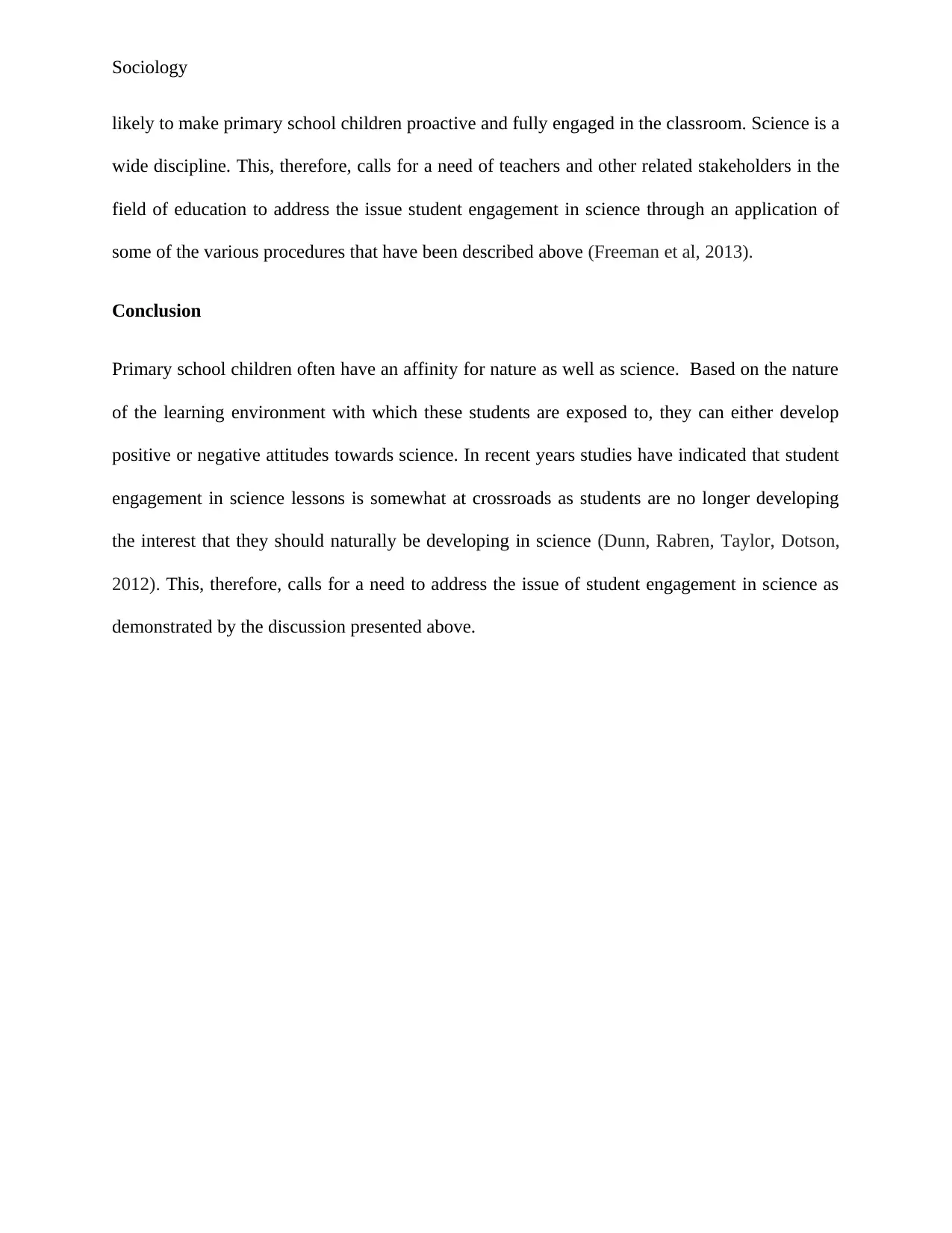
Sociology
likely to make primary school children proactive and fully engaged in the classroom. Science is a
wide discipline. This, therefore, calls for a need of teachers and other related stakeholders in the
field of education to address the issue student engagement in science through an application of
some of the various procedures that have been described above (Freeman et al, 2013).
Conclusion
Primary school children often have an affinity for nature as well as science. Based on the nature
of the learning environment with which these students are exposed to, they can either develop
positive or negative attitudes towards science. In recent years studies have indicated that student
engagement in science lessons is somewhat at crossroads as students are no longer developing
the interest that they should naturally be developing in science (Dunn, Rabren, Taylor, Dotson,
2012). This, therefore, calls for a need to address the issue of student engagement in science as
demonstrated by the discussion presented above.
likely to make primary school children proactive and fully engaged in the classroom. Science is a
wide discipline. This, therefore, calls for a need of teachers and other related stakeholders in the
field of education to address the issue student engagement in science through an application of
some of the various procedures that have been described above (Freeman et al, 2013).
Conclusion
Primary school children often have an affinity for nature as well as science. Based on the nature
of the learning environment with which these students are exposed to, they can either develop
positive or negative attitudes towards science. In recent years studies have indicated that student
engagement in science lessons is somewhat at crossroads as students are no longer developing
the interest that they should naturally be developing in science (Dunn, Rabren, Taylor, Dotson,
2012). This, therefore, calls for a need to address the issue of student engagement in science as
demonstrated by the discussion presented above.
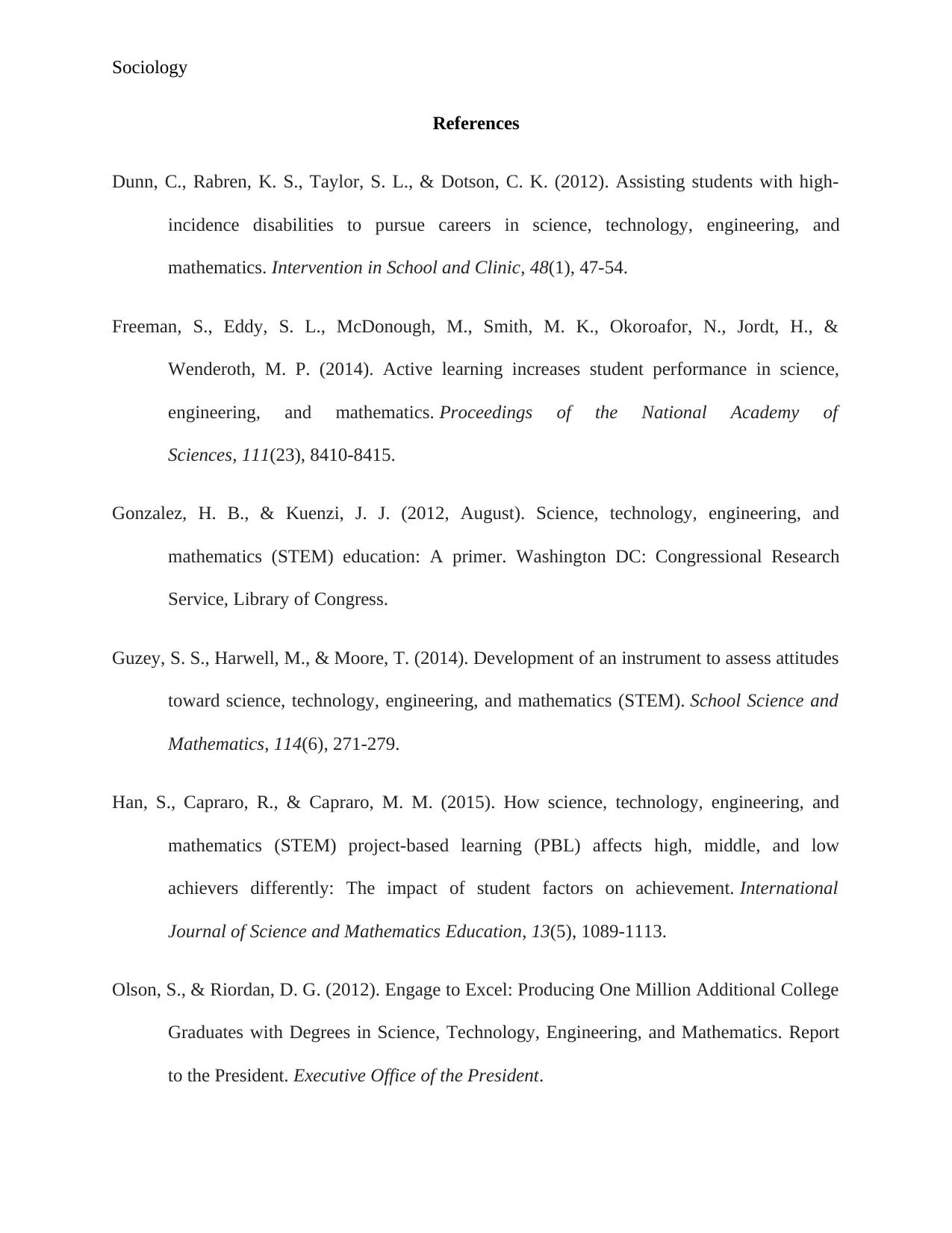
Sociology
References
Dunn, C., Rabren, K. S., Taylor, S. L., & Dotson, C. K. (2012). Assisting students with high-
incidence disabilities to pursue careers in science, technology, engineering, and
mathematics. Intervention in School and Clinic, 48(1), 47-54.
Freeman, S., Eddy, S. L., McDonough, M., Smith, M. K., Okoroafor, N., Jordt, H., &
Wenderoth, M. P. (2014). Active learning increases student performance in science,
engineering, and mathematics. Proceedings of the National Academy of
Sciences, 111(23), 8410-8415.
Gonzalez, H. B., & Kuenzi, J. J. (2012, August). Science, technology, engineering, and
mathematics (STEM) education: A primer. Washington DC: Congressional Research
Service, Library of Congress.
Guzey, S. S., Harwell, M., & Moore, T. (2014). Development of an instrument to assess attitudes
toward science, technology, engineering, and mathematics (STEM). School Science and
Mathematics, 114(6), 271-279.
Han, S., Capraro, R., & Capraro, M. M. (2015). How science, technology, engineering, and
mathematics (STEM) project-based learning (PBL) affects high, middle, and low
achievers differently: The impact of student factors on achievement. International
Journal of Science and Mathematics Education, 13(5), 1089-1113.
Olson, S., & Riordan, D. G. (2012). Engage to Excel: Producing One Million Additional College
Graduates with Degrees in Science, Technology, Engineering, and Mathematics. Report
to the President. Executive Office of the President.
References
Dunn, C., Rabren, K. S., Taylor, S. L., & Dotson, C. K. (2012). Assisting students with high-
incidence disabilities to pursue careers in science, technology, engineering, and
mathematics. Intervention in School and Clinic, 48(1), 47-54.
Freeman, S., Eddy, S. L., McDonough, M., Smith, M. K., Okoroafor, N., Jordt, H., &
Wenderoth, M. P. (2014). Active learning increases student performance in science,
engineering, and mathematics. Proceedings of the National Academy of
Sciences, 111(23), 8410-8415.
Gonzalez, H. B., & Kuenzi, J. J. (2012, August). Science, technology, engineering, and
mathematics (STEM) education: A primer. Washington DC: Congressional Research
Service, Library of Congress.
Guzey, S. S., Harwell, M., & Moore, T. (2014). Development of an instrument to assess attitudes
toward science, technology, engineering, and mathematics (STEM). School Science and
Mathematics, 114(6), 271-279.
Han, S., Capraro, R., & Capraro, M. M. (2015). How science, technology, engineering, and
mathematics (STEM) project-based learning (PBL) affects high, middle, and low
achievers differently: The impact of student factors on achievement. International
Journal of Science and Mathematics Education, 13(5), 1089-1113.
Olson, S., & Riordan, D. G. (2012). Engage to Excel: Producing One Million Additional College
Graduates with Degrees in Science, Technology, Engineering, and Mathematics. Report
to the President. Executive Office of the President.
⊘ This is a preview!⊘
Do you want full access?
Subscribe today to unlock all pages.

Trusted by 1+ million students worldwide
1 out of 15
Related Documents
Your All-in-One AI-Powered Toolkit for Academic Success.
+13062052269
info@desklib.com
Available 24*7 on WhatsApp / Email
![[object Object]](/_next/static/media/star-bottom.7253800d.svg)
Unlock your academic potential
Copyright © 2020–2025 A2Z Services. All Rights Reserved. Developed and managed by ZUCOL.





